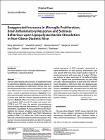| dc.contributor.author | HARKIN, ANDREW | |
| dc.contributor.author | McGuiness, Barry | |
| dc.contributor.author | Gibney, Sinead M. | |
| dc.contributor.author | Beumer, Wouter | |
| dc.contributor.author | Versnel, Marjan A. | |
| dc.contributor.author | Sillaber, Inge | |
| dc.contributor.author | Drexhage, Hemmo A. | |
| dc.date.accessioned | 2020-03-06T12:22:46Z | |
| dc.date.available | 2020-03-06T12:22:46Z | |
| dc.date.created | 2016 | en |
| dc.date.issued | 2016 | |
| dc.date.submitted | 2016 | en |
| dc.identifier.citation | McGuiness, B., Gibney, S.M., Beumer, W., Versnel, M.A., Sillaber, I., Harkin, A. & Drexhage, H.A., Exaggerated increases in microglia proliferation, brain inflammatory response and sickness behaviour upon lipopolysaccharide stimulation in non-obese diabetic mice, NeuroImmunoModulation, 23, 3, 2016, 137 - 150 | en |
| dc.identifier.other | Y | |
| dc.identifier.uri | https://www.karger.com/Article/FullText/446370 | |
| dc.identifier.uri | http://hdl.handle.net/2262/91711 | |
| dc.description | PUBLISHED | en |
| dc.description.abstract | The non-obese diabetic (NOD) mouse, an established model for autoimmune diabetes, shows an exaggerated reaction of pancreas macrophages to inflammatory stimuli. NOD mice also display anxiety when immune-stimulated. Chronic mild brain inflammation and a pro-inflammatory microglial activation is critical in psychiatric behaviour. Objective: To explore brain/microglial activation and behaviour in NOD mice at steady state and after systemic lipopolysaccharide (LPS) injection. Methods: Affymetrix analysis on purified microglia of pre-diabetic NOD mice (8-10 weeks) and control mice (C57BL/6 and CD1 mice, the parental non-autoimmune strain) at steady state and after systemic LPS (100 μg/kg) administration. Quantitative PCR was performed on the hypothalamus for immune activation markers (IL-1β, IFNγ and TNFα) and growth factors (BDNF and PDGF). Behavioural profiling of NOD, CD1, BALB/c and C57BL/6 mice at steady state was conducted and sickness behaviour/anxiety in NOD and CD1 mice was monitored before and after LPS injection. Results: Genome analysis revealed cell cycle/cell death and survival aberrancies of NOD microglia, substantiated as higher proliferation on BrdU staining. Inflammation signs were absent. NOD mice had a hyper-reactive response to novel environments with some signs of anxiety. LPS injection induced a higher expression of microglial activation markers, a higher brain pro-inflammatory set point (IFNγ, IDO) and a reduced expression of BDNF and PDGF after immune stimulation in NOD mice. NOD mice displayed exaggerated and prolonged sickness behaviour after LPS administration. Conclusion: After stimulation with LPS, NOD mice display an increased microglial proliferation and an exaggerated inflammatory brain response with reduced BDNF and PDGF expression and increased sickness behaviour as compared to controls. | en |
| dc.format.extent | 137 | en |
| dc.format.extent | 150 | en |
| dc.language.iso | en | en |
| dc.relation.ispartofseries | NeuroImmunoModulation; | |
| dc.relation.ispartofseries | 23; | |
| dc.relation.ispartofseries | 3; | |
| dc.rights | Y | en |
| dc.subject | Non-obese diabetic mouse | en |
| dc.subject | Microglia inflammation | en |
| dc.subject | Growth factor | en |
| dc.subject | Lipopolysaccharide | en |
| dc.title | Exaggerated increases in microglia proliferation, brain inflammatory response and sickness behaviour upon lipopolysaccharide stimulation in non-obese diabetic mice | en |
| dc.type | Journal Article | en |
| dc.type.supercollection | scholarly_publications | en |
| dc.type.supercollection | refereed_publications | en |
| dc.identifier.peoplefinderurl | http://people.tcd.ie/aharkin | |
| dc.identifier.rssinternalid | 176187 | |
| dc.identifier.doi | http://dx.doi.org/10.1159/000446370 | |
| dc.rights.ecaccessrights | openAccess | |
| dc.identifier.orcid_id | 0000-0001-9734-216X | |




